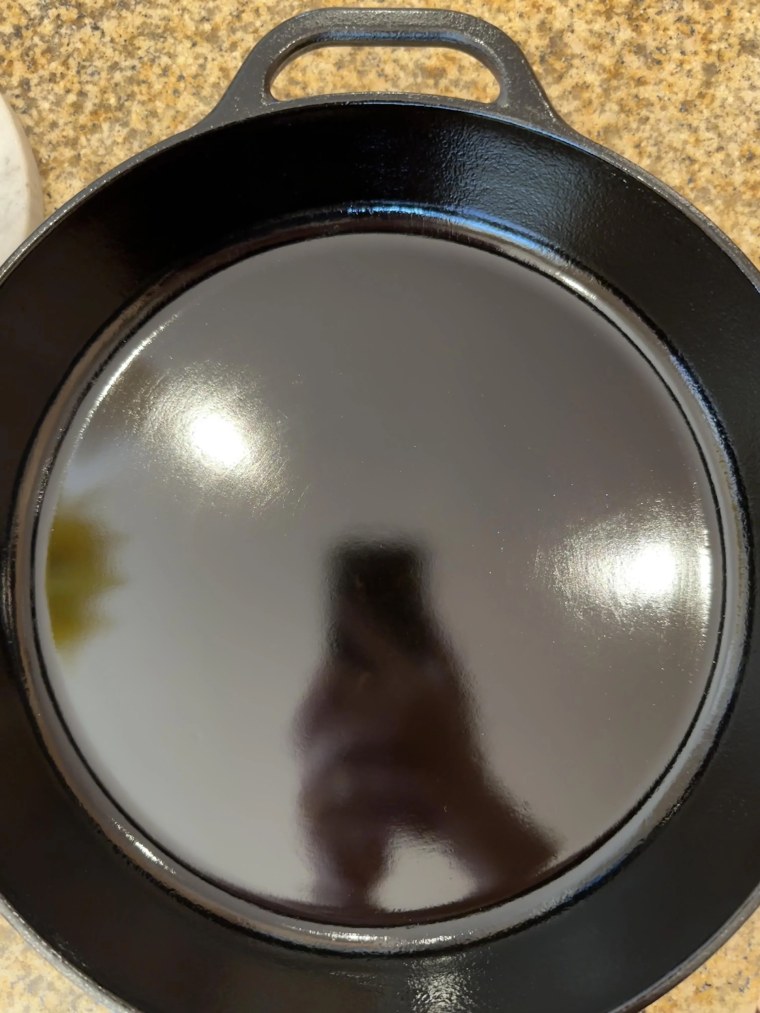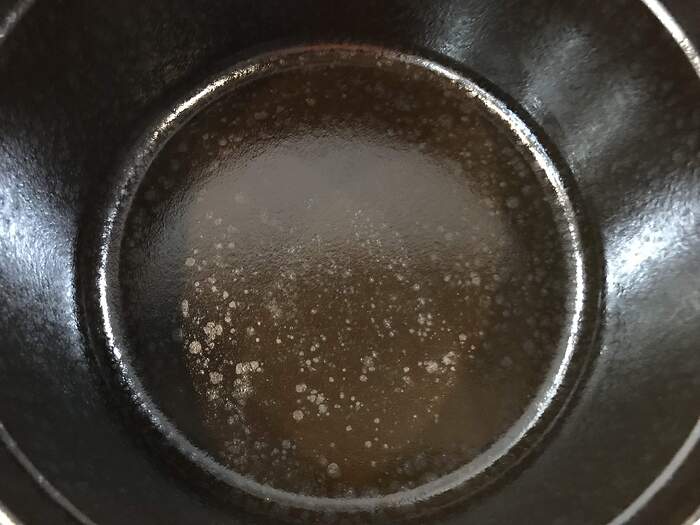Not me, someone did it.
Miserably, mine is polka dots like.
Did 3 of the Staubs today. Finally the last one came out more satisfying.
Are there ways to fix the first 2?
Wow. What a shiny coating.
paraphrasing . . . 'thick seasoning is required to make the rough surface smooth . . . "
. . . . and this is why people seek out ‘the old cast iron stuff’ that was polished smooth . . .
fwiw, there are cast iron polishing services offered, and web instructions/info on how to DIY.
I’m usually happy enough with a few coats. Like Tom says, maybe the dimples you’re getting are from pan texture? Are pans 2, 3 CI or CS? I don’t think I’ve seen CI with those nice, sloping sides like that.
My CI is all smooth-bottom, but still I do get surface imperfections on the coating like that if I don’t wipe the oil off cleanly enough while heating it - it will pool up into little circular dots and then harden.
The guy Dewey seems to have good spirits about it -
- This is just for internet clout and for “science”.
- And also to make random internet strangers unreasonably mad.
30-odd years ago I used to season using a thick layer of oil and heating it for an hour or so in the oven or on the electric hob at low temp, instead of thin wipings of oil at high heat.
One night I put a thick layer (about 4 mm deep) in it, put it on the stovetop on low, and got involved in homework and forgot about it. It ran all night and most of the next day as I was at classes and only discovered it was still on when I got home that afternoon.
I had polymerized the entire puck of oil. Best cooking surface I’d ever seen, but it wasn’t very durable and after about 10 days of fried eggs, I’d scooped enough divots out of the surface with my spatula that I just stripped it out and started over.
I still wonder if I’d let it go 2, 3, more days, would it have hardened up further, without cracking/splitting?
That Redditt sub is a lot of fun.
“Does this hurt the pan?”, one poster humorously asks. I have to wonder how the heck s/he did that, but it doesn’t seem to have been mentioned.
Another is “HELP! Would a steel scrubber help get this off?”

May I ask why you are seasoning your Staubs? Are they bare cast iron? Because I have only seen them with enamel–the black interior is actually enamel.
Unless you have some vintage pan I’m not aware of.
A steel scrubber will NOT work! Take it outside and use a hose with a good high pressure nozzle. Or you could put it in a black plastic bag with an SPCA approved cat cleaner.
They are enamel black interior, but not non-stick, with the crêpe pan, it’s essential to be non-stick to quickly cook the very thin pancake. The other dutch ovens, I don’t care to season until now, they are like 16 - 18 years old now. A week ago, I cooked 5 kg of onion to make confit, both of the pots has burnt residue that took me each half an hour to remove. So I think it’s time now.
Anyway, lesson learned, onion confit should stay with stainless steel pots, I cleaned another 2 SS pots in 3 minutes with a steel scrubber as I repeated the task.
I turned the dutch ovens upside down in oven when seasoning, I think maybe the heat of the cast iron pots isn’t heat up uniformly and caused the spots. I noticed that the inverted pans has a more uniform seasoning.
My first photo, I used more oil, and you see a shiny coating (only 1 coating), there are some slight drips marks on the side. The second photo, I just wipe oil on the pot, less oil was applied, the dimples were the drier spots.
I wonder pot turning upside is essential or not.
Now you remind me that I’ve a plastic container with cooking oil splashed and dried up on the surface, very difficult to get rid once dried. No heat was involved.
I am that contrarian who is not wild about turning seasoning into a project. I have two approaches. My carbon steel omelette pan has never had anything but butter to cook in and omelettes atop said butter. It gets wiped, not scrubbed. It became virtually nonstick years ago. My all purpose carbon steel just gets used. Sometimes it is sprinkled with salt and heat to start a steak, and sometimes it gets an oil or and oil and butter or ghee for other things. Sometimes it is soaked and scrubbed, and sometimes it takes no effort to clean. I really fear that putting a seasoned sheen on such a pan would make me nervous about how I used the pan. So the question for me is whether having a mirror finish seasoning is actually of use in cooking anything other than eggs or perhaps, delicate fish? i can certainly see it being a fun project, much like polishing a knife edge with 10,000 grit stones.
I saw that pan on another group. Poster said she took it off a hot burner and set it on a cool one. Left the room to do something and heard a noise in the kitchen. Came back to find the cracked pan. Consensus in the group was long and chronic thermal shock…some theorized that there may have been some water on the cool stove top that created just enough of a shock to finish the job.
I’m not a contrarian, I’m a realist.
got an old Griswold - logo dates it pre-1918 - sandblasted to bare metal and put into use
got several Darto black iron pans - they go thru the oven self clean cycle and put into use
I just cook fatty stuff in them to “season” - no ‘oils harvest by moonlight but only on the eastern slope’ stuff.
seasoning “happens” - does not require a Hollywood approach.
I seriously doubt any of our pioneer ancestors grew/collected/bought flax seed oil to season their cast iron pans. buffalo fat? yeah. flaxseed oil? not really . . .
My southern grandmother only cooked in cast iron skillets. There was an aluminum saucepan or two, and a big aluminum stockpot. Those skillets were black, but I don’t recall anyone fussing over them, or treating them with any special care or ritual. They just got used every day. I have my cast iron skillet from college. I don’t recall seasoning it, either. Just cooking in it with some kind of fat or oil. The ceremonies prescribed these days make me wonder what we were all doing wrong … or right.
Exactly. The finest seasoning I have ever acquired has been a CI pan I used exclusively for crepes.
Swab pan with neutral oil. Heat and make crepe. Remove crepe and reswab if necessary.
Repeat. Wash by wiping pan with hot, wet paper towel. Dry on gas stovetop. Repeat and repeat.
Many thanks. That sounds like a likely happenstance. It’s just amazing to me - how much I’ve “abused” my cast iron. Whoo - never imagined it could split like that!
Its a quirk, but it happens.
This will not end well after the first high heat cook.






